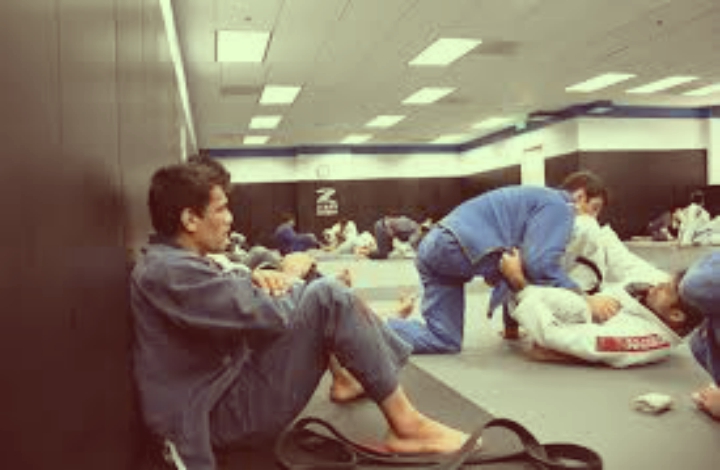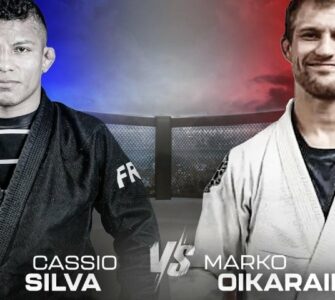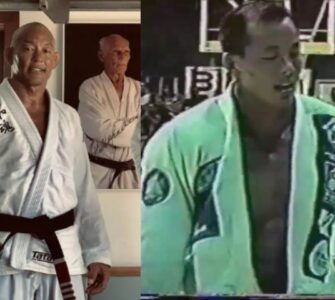Written by Johan De Wannemaeker brown belt from Prana BJJ Academia.
So you decided to give Brazilian jiu jitsu a try…and you loved it right away. Now you are seriously considering training a few times a week. It’s not going to be easy with a very tight work schedule, kids, partner, etc. but you are determined to go back to that kind of odd place where the air is filled with the conflicting smells of sports drinks, sweat and washing machine detergent. Where people from all sizes, colours and shapes meet in flashy gis, try to ‘kill’ each other and then hug afterwards.
If you are in the above situation you, first and foremost, need to be congratulated. Making this first baby step in taking the BJJ path is not a small feat by any means. In fact, you have chosen one of the most difficult paths life can possibly throw at you. It is littered with sacrifices, sweat, tears and pain. Many times your mind will beg you to quit…sometimes you will feel like all your strength has left your body…but still you will carry on…month after month, year after year…Why? because deep down inside you feel that, in the end, it will all be worthwhile. You will live more intensely from now on, no more playing for potato couch, stuffing yourself with junk food; spending all of your free time out in the pub drinking with your mates. No, you will create a new ‘you’…happier, leaner, faster, more confident ‘you’. And in the process you will also form lifelong friendships with others who have chosen the same path. Therefore, you need to be congratulated….
Although taking the first step was the most important one, the next one (choosing an academy) can sometimes be a bit of a struggle. As the martial art of BJJ has been expanding during the past few years, so have the number of academies. From garage dojos to hot shot academies with the surface like that of a supermarket…you will find it all in the world wide BJJ community. The choice you will make depends heavily on your expectations, available time and goals. However, as a beginner (with possibly no previous experience in martial arts whatsoever) you should pay attention to a number of ‘symptoms’, as they can unmask a ‘sickness’ the chosen academy suffers from.
1) The Disney land fight club: With the ever increasing popularity of BJJ, these types of academies are unfortunately on the rise but they are also the easiest to detect. Like with all martial arts that are becoming mainstream and popular, it tends to attract a growing number of people who try to jump on the bandwagon of success. Charlatans wearing black belts claiming non-existent lineages and titles. Usually they have very little experience in any grappling art and look like the only title they ever won was the one of a pie-eating contest. During the first class you attend, you will already discover that your shape and skill level is as ‘good’ as anyone else in the club. The instructor never rolls with his students and during the rare occasions he does you find out that you can actually tap him several times. Of course he will claim that he could kill you any time he wants because of his death touch. If you stay longer than one lesson in this type of academy you are probably stupid and deserve to be faked out of your time and money.
2) The blue belt factory: A distant cousin of the ‘Disney Land fight club’ but with the difference that the instructor is a legitimate BJJ black belt. First thing that stands out here is that the instructor is followed around by a group of ‘fans’. Often they will do activities together off the mat…going out to clubs, hiking, skiing, etc. Obviously there is nothing wrong with this and it’s not at all uncommon to see close friendships between people who have shared the mats for many years. However, if one elite BJJ artist let’s himself be complimented and celebrated by a bunch of ‘newbees’ it is usually a first sign of favouritism. Every member of the instructors’ inner circle seems to have at least a blue belt. Even if they have only been training for a short time, are out of shape or only train on occasion a promotion was given to reward them for their loyalty.
Individuals, who have a tendency to keep to themselves or are, for some reason, not integrated in the black belts’ group of buddies, will have to wait a lot longer for their coloured belts. You will see them with the virgin white belt on their waste although their skill levels are at least as good as any higher belt that trains there. In fact, the belt landscape in this academy is a mere reflection about one man’s preference for such or such individual. Typical for these types of gyms is that you hardly have anyone among its members that has been training for more than 5 or 6 years. It’s clear that the instructor, being an alpha male, doesn’t need the competition. Veterans, if any, complain about the slow pace during classes and overall weak level during rolling sessions. Having a more serious approach to BJJ will eventually force them away from the academy. Apart from thriving on favouritism the instructor will sometimes have the questionable habit of using his authority for personal benefits; if one of the members is, for example, a lawyer or a web designer he will seek their services…free of charge of course. As a freshman to BJJ, it might be very tempting to play the ‘buddy’ card to become a coloured belt as soon as possible. Every one of us has an ego which we like to feed as much as possible. For example, with a blue belt in BJJ. But if your promotion heavily depends on the instructor’s sympathy chances are you are fooling yourself. A trip to another (more serious) academy will usually leave you painfully exposed as you will be continuously thrown around and tapped by locals. Embarrassment and frustration will be the result. Ultimately, this could even lead to abandoning the art altogether.
3) The bully club: (This is for most people a no brainer but I throw it in anyway…). Normally you can already smell the testosterone when walking into one of these places. So it’s not a surprise that members of this academy look like they walked right out of a comic book. Tattoos, big muscles and shaved heads seemed to be the standard here. The walls are littered with cartoon pictures of pit bulls, anacondas and tigers posing in gis. Every session is literally do or die with a heavy emphasis on rolling. During the sparring sessions the participants will go all out; trusting more on their physical attributes then on acquired techniques. Injuries are frequent and considered as just part of the game in these types of academies. Usually an intimidating looking, broad-shouldered, middle-aged gorilla with impressive cauliflower ears is supervising the classes, yelling his instructions to everyone. A worn-out black belt with countless stripes dangles from his waist. Being a door bouncer in a local club, he has been in countless street altercations and is therefore no stranger to law enforcement. Apart from the danger of being seriously roughed up during rolling sessions, it’s quiet obvious that a ‘health club’ for local thugs and criminals is not the place where a sane, balanced individual wants to be. Leave. Nothing can be gained from training together with people that are looking to dismantle your body.
4) The black belt syndrome: Remember the stories about law enforcement officers that grow a few inches when putting on a uniform? They start behaving as if the world owes something to them. Just by putting on the uniform….The same principle applies to some practitioners who graduate to black belt. Once they have it around their waist, the delusions of grandeur raise in full glory. It becomes even worse if that person starts winning important tournaments. In that case the applied style & techniques not only become a valid option, it becomes THE option that excludes all the others. Students in these types of academies are only allowed to train/drill techniques that the instructor uses in his own style. Therefore they are known to be greatly one-dimensional BJJ practitioners. In competitions or open mats with other academies the ‘over emphasized’ position turns out to be as much a handicap as a strength. As this makes them very predictable the opponent will eventually be able to easily bypass the bread and butter guard and put the practitioner into a position that gets no or very little attention in the academy. Time after time will the lack of overall knowledge be awkwardly exposed. Thinking outside the box is not permitted in these places as the instructor does the thinking for you. If anyone shows interest in something that falls outside the instructor’s knowledge or interest it is quickly brushed away with a simple ‘forget about this and stick to the stuff I teach you’. Also in this case, you should ask yourself if training under these circumstances is really what you are looking for. A serious instructor will acknowledge the fact that BJJ is infinite and cannot be boxed and tailor-made into a single style to fit a whole academy. The techniques an individual prefers depend heavily on someone’s personal preferences, body type, physical ability, etc. Therefore, it is imperative that, besides basic techniques (armbars, hip escapes, etc), room is left for beginners to explore the vastness of BJJ for themselves. It is the task of a seasoned instructor to guide this process and offer assistance where needed.
5) Scientology team: This academy is nothing short of a sect. As humans have the social tendency to group together in tribes, the BJJ world is no exception. Usually academies are affiliated to schools that are led by experts who have devoted their life to the development of the BJJ art. Rivalry between schools is normal and reaches a climax during tournaments and open mat sessions. These guys, however, take the ‘tribe thing’ to a whole new level. New members are pressured to buy patches, gis or t-shirts with the school logo. Saying ‘no’ is not an option as all the merchandise stuff is made compulsory to attend the classes. Seminars by visiting instructors (read: sect leaders) are organized on a regular base. Again the pressure is on for everyone to attend and contribute an extra fee. Missing classes or fraternizing with other academies (‘the enemy’) is frowned upon. In some cases there might even be mental and/or physical abuse towards members who stepped out of line. Training or rolling sessions with other academies (very common in BJJ) are declined to keep outside influence at bay. Members that left the club or, even worse, have changed to another team are declared enemies and are often harassed on social media. Unfortunately, narrow-minded academies like these can make the whole BJJ experience very creepy. Always keep in mind that a substantive part of the attractiveness of BJJ lays in its potential to unite people from every corner of the world. As the chosen team, school or federation is merely a matter of circumstances and personal preference the universalness of BJJ should always be prioritized over tribal interests.
6) The drill kids: Most members in these kind of academies are usually very young and all they seem to do is drill, drill and drill some more. Approached they will tell you how drilling is embedding the techniques into your muscle memory system and in the same breath ask if you have seen the awesome, new mantis guard that Cornelius used on Lucas Leite at the recent mundials. You have no idea what they are talking about but it’s pretty clear that these guys live and breathe Jiu jitsu. The walls covered with medals from elite tournaments only confirm this assumption. Soon you learn about techniques with names like “legdrags” or “berimbolos”. All of them are drilled in a high-speed, repetitive fashion. As a beginner your head is spinning from seeing all these entangled arms and legs. Even if your life depended on it, you simply don’t see yourself do this. A first attempt during one of these so-called ‘drill classes’ goes horribly wrong as ‘the reverse de la riva to x-guard to 50/50 and back take’ is way too much for your motoric skill levels. Doesn’t matter how often the technique is explained; you just can’t get all the steps in the correct order. Frustrated and feeling somewhat like a motoric moron, you are convinced BJJ is not for you. BJJ is a constantly evolving art with a high popularity among youngsters. Although this should be applauded we should never forget that it is in the first place a universal art meant for everyone to participate. A serious academy will take this into consideration and appeal to both the 20-year old elite competitor and 54-year old woman who wants to boost her self-confidence. Therefore an academy might opt to split classes into beginners and elite sessions; Q&A and privates could also be introduced, etc. This way nobody gets left behind.
Most academies will usually ‘suffer’ from one or more of the above described ‘symptoms’. When present in a mild form it will not affect the overall health status of an academy. So next time the instructor asks if you are interested in buying a new gi with the academy logo, don’t be alarmed right away. However, alarm bells should go off when the behaviour follows a pattern and is recurrent. Detecting these kinds of dangers might just prove to be the difference between an enjoyable BJJ experience and loss of money, time and frustration.

















